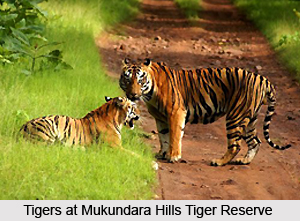 Mukundara Hills Tiger Reserve, situated in south eastern border of Kota in Rajasthan, is a densely forested third tiger reserve of the state. It is precisely located in the Hadoti region of Rajasthan. It was formerly known as Mukundara Hills National Park and has been declared as a tiger reserve in the year 2012 by the Government of India. It includes three wildlife national parks namely Darrah, Jawahar Sagar and Chambal. In the bygone era the place served as a hunting preserve of Maharaja of Kota. It spans over a large area of about 250 square kilometres and is well maintained by the Government of Rajasthan to save the tigers of the reserve.
Mukundara Hills Tiger Reserve, situated in south eastern border of Kota in Rajasthan, is a densely forested third tiger reserve of the state. It is precisely located in the Hadoti region of Rajasthan. It was formerly known as Mukundara Hills National Park and has been declared as a tiger reserve in the year 2012 by the Government of India. It includes three wildlife national parks namely Darrah, Jawahar Sagar and Chambal. In the bygone era the place served as a hunting preserve of Maharaja of Kota. It spans over a large area of about 250 square kilometres and is well maintained by the Government of Rajasthan to save the tigers of the reserve.
Mukundara Hills Tiger Reserve is accredited as the 5th largest tiger reserve as per the records of Government of India. It played an important role in reducing the tiger population pressure in Ranthambhore. On the recommendation of the National Tiger Conservation Authority, the State Government has notified the area as a tiger reserve under section 38 V of the Wildlife Protection Act, 1972. Initially it did not have its own tiger population but acted as a natural extension of Ranthambhore tiger reserve and for tigers from other famous reserves of the state which often stray in this area for breeding. It has also been recognized as an extension of the core area of the Ranthambhore tiger reserve by the NTCA.
Flora and Fauna of Mukundara Hills Tiger Reserve
Mukundara Hills Tiger Reserve is a dense forest and hosts a vast variety of flora including many medicinal plants. Owing to its dense forestation, it has emerged as a prominent tourist spot of Rajasthan. It is the home to about 50 tigers and several species of reptiles, mammals and birds. Common species of animals here, other than tiger, include leopards, sloth bears, wolves and chinkaras.
Visiting Information
Mukundara Hills Tiger Reserve is best visited from January to March owing to the dry climate. The nearest railway station to reach here is Kota whereas the nearest airport is Sanganer Airport in Jaipur. Bus services also connect various Indian cities to Kota from where a private cab, jeep or taxi can be hired to reach Mukundara Hills Tiger Reserve.











